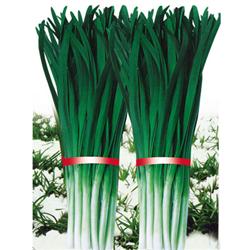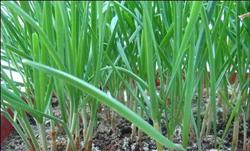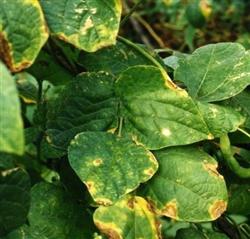Video pictures of leek planting techniques

Leek is a perennial root plant with unique flavor, delicious spice and rich nutrition, which can be supplied all the year round. it plays an important role in enriching vegetable varieties, meeting consumer demand and increasing people's income. Planting leek can refer to the following methods: first, select excellent leek species: the famous leek with enlarged leaves, thicker pseudostem and higher yield should be selected; the leek with erect leaves, dark green leaves, less fiber, late bolting and good quality should be selected. Hanzhong leek with more tillers, stout pseudo-stem, hypertrophic leaves, strong cold tolerance, high yield, cold tolerance, early return to vegetables, strong tillering ability, wide stem and wide leaves, fragrant single root red (9-1); leaf color light green, early germination, leaf hypertrophy, cold tolerance, strong regeneration ability of 791 snow leek; erect clump, rapid growth, strong tillering ability, cold resistance, disease resistance, green leaf sai Qing, etc., can be selected in a planned way. 2. Cultivating leek seedlings: 1. The sowing time of leek in North China is more than that in the first and middle of April, and the local temperature steadily passes 10-12 ℃. 2. Preparation of leek seedbed: select plots that are loose and fertile, convenient for drainage and irrigation, and have not been planted with onions and garlic for 3 years. After the previous harvest, 500 kg of rotten organic fertilizer and 50-60 kg of ternary compound fertilizer are applied per mu, ploughing and raking fine, and the whole is turned into a flat border with a width of 1.6-2 meters and a length of 8-10 meters. 3. Leek seed treatment methods: in order to promote post-ripening and improve germination rate, sun-drying seeds for 2-3 days before sowing. Soak the seeds in 40 ℃ warm water for 24 hours, remove, wash and drain, wrap them in a wet cloth and put them in a 20-25 ℃ environment to accelerate germination. After about 3 days, 80% of the seeds can be sown. 4. The sowing quantity of leek: the suitable density for raising seedlings per square meter is 1600 plants, and the seed is about 10 grams. According to 80% of the actual sowing area, it is necessary to sow about 5 kilograms per mu. The nursery seedlings can be planted twice as much as the seedbed. 5. Leek sowing method: pour enough bottom water before sowing, spread a thin layer of fine soil before sowing, lest the seeds get muddy and affect breathing, then spread the seeds evenly into the seedbed, cover the fine soil 1.5 cm after sowing, and the second largest cover fine soil 1 cm. This can disconnect the upper and lower layers of the soil capillaries and keep the topsoil loose and moist, which is conducive to the emergence of seedlings. 6. Leek seedling stage management: keep the soil moist after leek emergence, water in time when the seedling height is 4-6 cm, and then water every 5-6 days. When the seedling height is 10 cm, apply 10 kg urea per mu. When the seedling height is 15-20 cm, then apply 10 kg of urea, that is, you should squat seedlings to promote the coordinated growth of the above ground and underground parts. Pay attention to the prevention and control of diseases, pests and weeds. Third, the transplanting and planting of leek: 1. The determination of the planting period of leek: when the height of the plant reaches 20 cm or when the seedlings are crowded, we should pay close attention to the planting, generally reaching the planting standard 50-60 days after emergence. Planting should not be later than the first ten days of July, otherwise it can not escape the high temperature and rain in July and August, which is not conducive to the survival of seedlings. 2. Arrangement and fertilization of leek cultivation land: after the previous harvest, apply high-quality soil and miscellaneous fertilizer 4000-5000 kg per mu, deep ploughing 25-30 cm, rake fine, 1. 6-2 meters wide, 20-25 meters long. 3. The planting density of leek: the suitable row spacing is 20-25 cm, the pier spacing is about 15 cm, and each pier has about 25 leek seedlings. The pier distance can also be appropriately shortened, the number of seedlings per pier can be reduced accordingly, and it is appropriate to keep about 800 seedlings per square meter. 4. The planting method of leek: the leek seedlings should be planted along with the planing, not stacked for a long time. After ploughing out the seedlings, cut off the root tip, leaving only 2-3 cm, and then cut off a section of the leaf tip to reduce leaf evaporation. According to the planned pier line distance to dig holes or trenches, each hole planted leek seedlings, bulbs to be complete, between plants to be compact. Bulb top buried in the soil 3-4 cm, too deep growth is not prosperous, too shallow root jump too fast. The leek mound is compacted with soil. Fourth, leek field management: 1, leek planting management in the first year: in order to ensure the survival of seedlings, watering immediately after planting. When new leaves appear and new roots occur, 25-30 kg of urea is applied per mu. Pay attention to drainage and weed removal during the rainy season. In the middle of August, 200kg per mu of topdressing cake fertilizer or 1000-1500 kg of rotten barnyard manure, the fertile soil should be mixed well and watered immediately. Water it every 5-6 days. In the middle of September, 25-30 kg of urea per mu or 50-60 kg of ternary compound fertilizer per mu to keep the soil dry and wet. Before freezing the soil, pour enough frozen water to facilitate overwintering and bud germination in the following spring. 2. The management of leek in the second year of planting: after the leek has grown to 2 years, the annual management method is similar. In early spring, withered leaves and weeds were removed from the border in order to raise the soil temperature and promote germination. In order to prolong the life span of leek and promote the development of new roots, new soil with a thickness of 2-3 cm should be spread on the border, and 2000-3000 kg of rotten organic fertilizer should be applied per mu. After the new buds are unearthed, water the human and animal dung once and water the seedlings when they are 15-18 cm high. To 2-3 days after harvest, fertilizer and watering, each harvest, 30 kg of urea per mu. In summer, we should pay attention to both drainage and ventilation. Autumn is the vigorous growth period of leek, strengthen fertilizer and water management. About 50 days before the local leek withered, stop harvesting, make it wither naturally, transfer nutrients to the root, and lay a good foundation for the robust growth of leek in the next spring. Fifth, the prevention and control methods of diseases and insect pests of leek: the main diseases of leek are downy mildew, gray mildew, blight and so on. Carbendazim, aluminum ethyl phosphate, metalaxyl, frost clear, gray mildew, Kelu and other agents can be used for control. The main pests of leek are leek maggot, thrips, Plutella xylostella, leaf miner and so on. Dimethoate, phoxim, dichlorvos, permethrin and pyrethroids can be used for control. There are 33% herbicide, 48% propranolol and 50% herbicide in leek field before budding. There are 48% trifluralin, 25% herbicide, 50% riguron and so on. Before using herbicides, you should read the instructions carefully to prevent drug damage. Sixth, the harvest of leek: 1, the season of harvest of leek: in spring, the leaves grow vigorously, which is the main harvest time. With high temperature and rainy summer, the quality becomes worse and more unharvested. In autumn, the leaves grew vigorously again, and there was another harvest period. If protected cultivation is implemented, it can also be supplied to the market in winter. 2. Leek harvest frequency: chives are generally harvested 5 or 6 times a year, such as good fertilizer and water conditions and proper management, they can be harvested 7 or 8 times. Generally, the yield per mu is 4000-50000 kg, and the high yield can reach 7000-8000 kg. Five years is a harvest cycle. 3. The harvest method of leek: when the seedling is about 35 cm high, and the growing period is 20-25, it can be harvested. The yield is affected prematurely and the quality is affected too late. The harvest time should be sunny morning. Because the meristem is at the base of the leaf sheath, generally leaving stubble 2-3 cm, too low will damage the meristem and buds. Click to get more leek planting techniques click to get more vegetable planting techniques
- Prev

What should summer plant leek notice?
What should summer plant leek notice? Summer planting leek: hot and rainy, summer leek management should pay attention to weeds, drainage and waterlogging, strengthen fertilizer and water management and pest control, and reduce the number of harvests to promote the exuberant growth of leek. Cut-free: high temperature in summer leads to less nutrient accumulation and high consumption of leek.
- Next

How to control bean anthracnose?
What are the dangers of bean anthrax? How to control bean anthracnose? Please also understand the net friend to help introduce the cultivation network collated bean anthracnose harm and prevention methods, the following detailed list for the reference of netizens. The harm of bean anthracnose: bean anthracnose belongs to fungal disease, in more dew,...
Related
- Where is it suitable to grow horseradish in China? it is expected to see the middle altitude horseradish in Alishan.
- How to prevent tomato virus disease reasonably? (Control methods included)
- Many people like to plant towel gourd on the balcony. What are the main points of this method and management?
- What crops can chili peppers be mixed with?
- Fertilization techniques and matters needing attention in Tomato
- What are the grafting techniques for peach seedlings in spring?
- Harm and control methods of root swelling disease of Chinese cabbage
- What are the pests of sweet potatoes? How to prevent and cure it?
- Symptoms, causes and Control methods of navel Rot in Tomato
- The cause of "Cucumber rotten bibcock" in Farmers' planting Cucumber and its Control Plan

